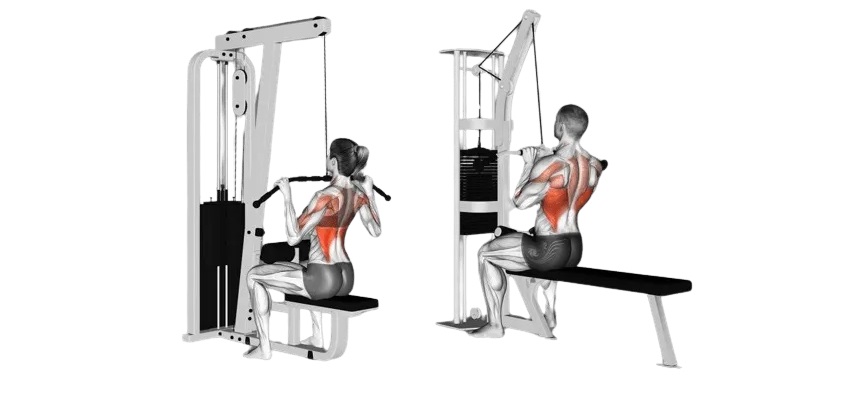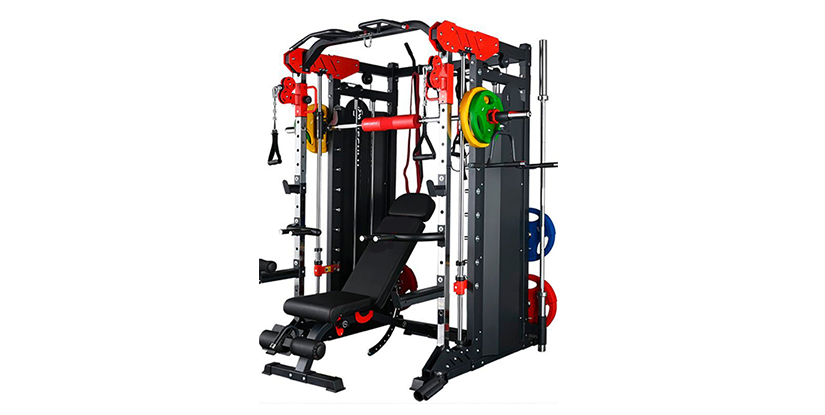The first time I hit a 50 kg lat pulldown clean in a commercial gym, I felt like a beast.
It moved smooth, back was tight, elbows tucked — solid rep. I thought, Alright, I’m making gains.
But then, a dude two stations down casually cranked out 80kg for 12 reps like he was warming up for a nap.
That’s when it hit me: Is 50kg actually good? Or am I just hyping myself up too soon?
So yeah, I went digging.
50kg Means Different Things for Different Lifters
So after pulling 50kg on the lat pulldown, I started looking around the gym more.
And yeah — turns out, what feels heavy to one person might be someone else’s warm-up set.
At first, that messed with my head. But then I realized a few things:
- Bodyweight matters. If you’re 60kg and pulling 50kg, that’s solid work. You’re basically moving almost your whole body.
- If you’re 90kg+, that same 50kg pull? Might not be enough to challenge your back.
- Experience plays a role too. Newer lifters will find 50kg heavy. More advanced folks? They’re usually working with 70–90kg+ easy.
- Goals shift the standard. Strength-focused? You’ll want more weight. Chasing hypertrophy? You might stick with 50kg and grind out clean reps.
Basically, it all depends. What feels heavy is totally relative — but in a commercial gym, you see it all.
And that helped me stop comparing and start training smarter.

How Much Weight for Lat Pulldown
After digging through Reddit threads and fitness calculators, I wanted to know — like, objectively, where does 50kg sit?
Turns out, it depends on sex, bodyweight, and form. But here’s a simple breakdown I wish I had earlier:
For Men Lat Pulldown Average Weight
In most commercial gyms, these are the general ballpark ranges:
| Strength Level | Weight | Bodyweight Ratio |
|---|---|---|
| Beginner | 38 kg | 0.50x |
| Novice | 58 kg | 0.75x |
| Intermediate | 82 kg | 1.00x |
| Advanced | 110 kg | 1.50x |
| Elite | 141 kg | 1.75x |
For Women Lat Pulldown Average Weight
Women’s numbers are different, but 50kg is no joke here:
| Strength Level | Weight | Bodyweight Ratio |
|---|---|---|
| Beginner | 19 kg | 0.30x |
| Novice | 31 kg | 0.45x |
| Intermediate | 46 kg | 0.70x |
| Advanced | 64 kg | 0.95x |
| Elite | 83 kg | 1.30x |
So yeah — 50kg on lat pulldown is right around intermediate for most lifters.
If you’re repping it with control and full range? You’re doing just fine.
And in a commercial gym? You’ll see everything from 20kg baby reps to 100kg half-pulls. Focus on your lane.
What Really Affects How Heavy 50kg Feels
At first, I thought 50kg just came down to brute strength. But once I actually paid attention in the gym — and stopped ego lifting — I realized there’s way more to it.
Here’s what actually makes 50kg feel heavy (or not):
Your Size Matters
If you weigh 60kg, pulling 50kg is no joke. That’s close to bodyweight resistance.
But if you’re a 100kg unit? It won’t hit the same. You’ll need more load to challenge your lats.
Experience Changes Everything
When I first started lat pulldowns, even 40kg felt like a battle.
But with time, I learned how to brace better, control the descent, and feel the muscles working.
So yeah — how long you’ve been training absolutely matters.
Form: The Hidden Cheat Code
This was the biggest one for me.
At first, I was yanking the bar with my arms and rocking back — basically just cheating the weight down.
Once I focused on strict form — chest up, elbows down, pulling with my lats, not just my biceps — the same 50kg felt twice as hard, but also twice as effective.
Bottom line? 50kg can feel light or brutal depending on the lifter, not just the number on the stack.
How I Broke Past the 50kg Plateau
Getting stuck at 50kg on the lat pulldown was frustrating. I kept yanking, grunting, and grinding through it — but nothing moved. So I did something that felt kind of backwards… and it worked.
Started Lower | Yeah, Really
- I swallowed my pride and dropped back to 40kg.
- Didn’t love it, but it let me fix my form and actually feel the right muscles working.
- That was the first step forward.
Focused on Form Cues
- I stopped pulling with my arms and started pulling with my elbows.
- Leaned back just a bit, braced my core, kept the bar path tight — that made a huge difference.
- Honestly, just slowing the rep down made it 10x harder (and more effective).
Progressed Slowly
- No more big jumps. I started adding just 2.5 to 5kg at a time.
- Didn’t touch the next weight until I could control every rep.
- No jerking, no momentum — just clean pulls, full range, and a slow eccentric.Not flashy. Not fun. But it worked.
- If you’re stuck at 50kg, this kind of reset might be what you need too.
Lat Pulldown Weight Standards & 8-Week Training Plan
Below are two beginner-friendly training plans — one for men and one for women. These plans help you progressively build strength and technique in line with what is considered lat pulldown normal weight at the beginner level, moving toward intermediate and beyond.
Each plan gradually increases lat pulldown weight (kg) over 8 weeks, based on averages from the strength standards.
Lat Pulldown Training Plan for Men (Beginner to Intermediate)
Target Audience: Beginner men aiming to progress toward intermediate-level lat pulldown performance.
Starting Point: Based on Strength Level data, beginner men typically lift around 47 kg (104 lbs) as lat pulldown normal weight.
Goal Progression:
- Start with 40–50 kg, aiming to reach 60–70 kg over 8 weeks
- Develop controlled form, lat engagement, and vertical pull strength
Weekly Layout (2x/week)
| Week | Lat Pulldown Weight (kg) | Sets x Reps | Notes |
|---|---|---|---|
| Week 1 | 40 | 3 x 10 | Focus on form, scapular control |
| Week 2 | 45 | 3 x 10 | Add 5kg if no form breakdown |
| Week 3 | 47.5 | 3 x 8–10 | Aligns with beginner lat pulldown weight standards |
| Week 4 | 50 | 3 x 8 | Optional: Add back accessory row exercises |
| Week 5 | 52.5 | 4 x 8 | Slight increase; emphasize slow negatives |
| Week 6 | 55 | 4 x 6–8 | Engage lats fully, avoid swinging |
| Week 7 | 60 | 4 x 6 | Entering intermediate range |
| Week 8 | 65–70 | 4 x 5 | Only if controlled, matching strength levels |
Lat Pulldown Training Plan for Women (Beginner to Intermediate)
Target Audience: Beginner women working toward improving strength and mastering pulling movements.
Starting Point: According to the lat pulldown weight standards, beginner women typically lift 24 kg (53 lbs) as lat pulldown normal weight.
Goal Progression:
- Begin at 20–25 kg and aim to reach 35–40 kg over 8 weeks
- Prioritize mind-muscle connection and control
Weekly Layout (2x/week)
| Week | Lat Pulldown Weight (kg) | Sets x Reps | Notes |
|---|---|---|---|
| Week 1 | 20 | 3 x 10 | Establish technique, no leaning |
| Week 2 | 22.5 | 3 x 10 | Progress slowly; control is key |
| Week 3 | 24 | 3 x 8–10 | Standard beginner lat pulldown weight kg |
| Week 4 | 25 | 3 x 8 | Optional: Add assisted pull-up machine |
| Week 5 | 27.5 | 4 x 8 | Pull elbows straight down, not back |
| Week 6 | 30 | 4 x 6–8 | Begin building toward intermediate level |
| Week 7 | 32.5 | 4 x 6 | Maintain full range of motion |
| Week 8 | 35–40 | 4 x 5 | Only increase if technique stays perfect |
General Tips for Both Plans
- Warm-up: Always do a light warm-up set with 50% of working weight
- Rest: 60–90 seconds between sets
- Form First: Never sacrifice technique just to meet a weight standard
- Progress Tracking: Use a journal or app to track weekly improvements
Understanding lat pulldown weight standards helps you train more intentionally. These plans guide you from beginner-level lat pulldown normal weight (24 kg for women, 47 kg for men) to stronger levels in 8 weeks. The key is progressing your lat pulldown weight kg gradually, while maintaining form and avoiding stress on the shoulders or lower back.
When it comes down to it, pulling 50kg on the lat pulldown is a solid benchmark—especially in a commercial gym where form and steady progress matter most. Keep your technique sharp, stay consistent, and the gains will follow.
FAQs about 50 kg Lat Pulldown
Yes, lifting 50 kg on the lat pulldown is considered a strong performance for many lifters. It represents a significant achievement, especially for those at beginner or intermediate levels. For male lifters, 50 kg aligns with average expectations at the early stages of strength training. For female lifters, it is an above-average weight and often signals advanced progress.
Achieving this milestone demonstrates a good balance of strength and technique. Proper execution with controlled movement ensures that the targeted muscles, such as the lats, are effectively engaged. Reaching this level also requires consistency in training and a commitment to gradual progression. For those aiming to surpass this weight, incorporating complementary exercises like dumbbell rows and pull-ups can further enhance back strength. Overall, 50 kg is a commendable goal that many lifters strive to achieve in commercial gym settings.
A good lat pulldown weight depends on the lifter’s strength level, experience, and fitness goals. For beginners, 15 to 30 kg is often recommended to build foundational strength and proper form. Intermediate lifters typically handle 30 to 50 kg, with the upper range indicating solid progress. Advanced lifters can exceed 50 kg, demonstrating mastery of the exercise.
Setting a “good” weight also depends on body weight and training frequency. Lifters with consistent routines and proper technique will naturally progress to heavier weights over time. It’s important to choose a weight that challenges the muscles while maintaining control. Overloading too quickly can lead to improper form or injury.
To determine your ideal weight, start with a manageable resistance and focus on gradual increases. Commercial gym equipment often includes weight increments that allow for steady progression. Tracking your weights and repetitions helps evaluate performance and adjust goals accordingly.
The heaviest lat pulldowns performed in professional competitions or by elite athletes can exceed 100 kg. These achievements showcase exceptional strength and years of advanced training. While records vary, some athletes have reportedly completed lat pulldowns with weights reaching 150 kg or more.
Such feats require not only immense back strength but also a strong grip and proper technique. Professional lifters often use specialized equipment and follow strict training regimens to achieve these remarkable results. These extreme performances are far beyond the average lifter’s capabilities and should not be seen as routine goals.
For most gym users, aiming for gradual progress toward heavier weights, like 50 kg or 60 kg, is a more realistic and safe approach. Achieving world-record weights is rare and requires a level of dedication typically seen in competitive bodybuilding or powerlifting environments.
Going heavy on lat pulldowns can be beneficial, but it must be approached with caution. Choosing a weight that challenges your muscles is important, but maintaining proper form is essential. Lifting too heavy can lead to improper technique, such as using momentum or failing to engage the lats effectively.
For safe progress, start with a weight you can control and perform with a full range of motion. Gradual increases in resistance allow your muscles to adapt and grow stronger over time. Heavier weights are ideal for building strength, but lighter weights with higher repetitions can improve endurance and muscle tone.
Consistency and a well-structured routine are key to balancing heavier weights with proper execution. Avoid overloading too quickly, as this can increase the risk of injury. Commercial gym settings often provide adjustable increments, making it easier to find a suitable weight for both strength and technique development.
As of now, there is no officially recognized world record for the lat pulldown in the same way that there are records for standardized lifts like the bench press, squat, or deadlift. The lat pulldown is considered a machine-based assistance exercise, and because of its variability in equipment design, resistance type, and exercise form, it’s not standardized across competitions. This makes it difficult for strength federations to set or certify a universal record.
However, there are anecdotal reports and unofficial feats of strength by bodybuilders and strength athletes. Some advanced lifters have claimed to perform lat pulldowns with weights exceeding 120–140 kg (265–310 lbs) for multiple reps. For example, IFBB pros and elite powerlifters have been filmed pulling massive weights—sometimes using momentum (leaning back or jerking)—which makes those numbers impressive but not directly comparable to strict-form pulldowns.
In a controlled form (strict upright posture, full range of motion, and no swinging), pulling over 100 kg (220 lbs) is considered elite for men, and over 60–70 kg (130–155 lbs) is elite for women. So while there isn’t an official world record, the performance ceiling in real-world gym settings can be incredibly high for top-tier athletes.
The maximum weight capacity of a lat pulldown machine depends on the manufacturer, model, and intended use. Most commercial-grade lat pulldown machines—like those found in gyms—have weight stacks that range from 90 kg (200 lbs) up to 120 kg (265 lbs). Some high-end commercial models may offer stacks up to 150 kg (330 lbs) or more.
There are also selectorized lat pulldown machines (with pins and stacks) and plate-loaded lat pulldown stations. Plate-loaded models don’t have a fixed weight limit in the stack but are limited by the structural capacity of the machine frame—typically able to handle up to 200–250 kg (440–550 lbs).
Ultimately, if you’re trying to train heavy on the lat pulldown, a commercial plate-loaded or high-capacity stack machine is ideal. Always check the manufacturer’s safety specs, especially if you’re approaching the machine’s maximum resistance range.
This question is more complex than it seems because the actual resistance felt during a lat pulldown isn’t always equal to the number displayed on the machine’s weight stack. Several factors influence how much weight you’re really lifting:
Pulley System Efficiency: Most lat pulldown machines use pulley systems to guide the cable. Depending on the number of pulleys and the angle of the cable path, mechanical advantage (or disadvantage) can alter how the load feels. For example, if a machine uses a 2:1 pulley ratio, lifting 60 kg on the stack might feel more like lifting 30 kg.
Friction and Cable Tension: Friction between pulleys and cables also reduces efficiency. Older machines may “feel” heavier due to worn pulleys, cable drag, or misalignment, even if the weight stack number hasn’t changed.
Stack Calibration: Not all stacks are calibrated accurately. Some may list weight plates as 5 kg, but in reality, they could weigh 4.5 or 5.5 kg, depending on the manufacturer.
Body Angle and Form: If you lean back slightly or use momentum during the pull, it reduces the actual resistance your lats are lifting. In strict form, you’re using more muscle effort per kg, making the weight feel heavier.
While the number shown might say lat pulldown weight kg = 60 kg, the actual resistance could feel slightly heavier or lighter. The best way to monitor progress is by maintaining consistent form and tracking your perceived effort along with the weight.

Hi, I’m the editor here at Leadman Fitness. We’re a manufacturer focused on producing top-quality barbells, plates, kettlebells, dumbbells, and strength training gear. I’ve been into sports and fitness for years, and I know my way around all kinds of gym equipment—both from using it and helping create it.
I spend a lot of time understanding the real problems people run into in the gym—whether it’s beginners trying to pick the right gear or experienced lifters looking for something more durable. I stay in close touch with our production team and talk directly with other equipment makers, so we’re always improving based on what real lifters and coaches are looking for.
What I share comes from hands-on experience—stuff that actually helps people train better, not just in theory, but in real gyms.
